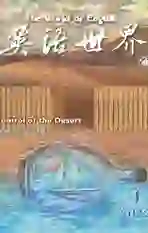The Man Who Stopped a Desert Using Ancient Farming用古老农耕法止退沙漠的人
2022-04-27吴明仁译/程颋
吴明仁(音) 译/程颋
Desertification is a serious problem facing numerous countries in the world today. Various measures have been taken to counter the negative effects, with some providing better results than others.
‘Modern’ innovations as well as traditional practices have been taken trying to stop the negative impact of desertification. The successful application of the latter is apparent in the case of Yacouba Sawadogo, a farmer who took the initiative to combat desertification in his country by using simple, traditional methods.
Taking matters into his own hands1
Yacouba Sawadogo is a farmer from Burkina Faso. The northern area of this African country lies within the Sahel, a semi-arid region sandwiched2 by the Sahara Desert in the north and the Sudanian Savanna in the south. Desertification has been a serious problem in the northern part of Burkina Faso since the 1970s.
As a result of over-farming, over-grazing, and over-population, the soil in this region has suffered from heavy erosion and drying over the decades. Efforts have been made both on a national and international scale to remedy the situation, though to no avail3.
It was during the 1980s that Sawadogo, seeing that the measures taken by the authorities were not producing results, decided to take matters into his own hands. Sawadogo employed two traditional methods—Zaï4 and cordons pierreux5, in his battle against the desertification of his country. As these traditional ways were regarded as odd by his community, Sawadogo was initially thought to have lost his mind, and was ridiculed.
Two farming techniques
Zaï is a farming technique which has been used traditionally in the western part of the Sahel, which includes Burkina Faso. In essence, this technique involves the digging of holes in soil that is not very permeable, so that runoff can be collected. These holes have a depth that range from 5 to 15 cm (1.97–5.91 inches), and a diameter of between 15 and 50 cm (5.91–19.69 inches). Fertilizers or compost may be placed in the holes to increase the amount of nutrients in the soil. Crops may then be planted in these holes.
The advantages of this technique are many. For instance, this is a simple and cheap technique that may be utilized by any farmer. It is, however, a labor-intensive technique, and therefore, the cost is higher in terms of manpower. In addition, farmers need to monitor and maintain their Zaï holes. Nevertheless, the efficacy of Zaï is evident, as its use has resulted in increased crop yield.
Another traditional technique employed by Sawadogo is known as cordons pierreux. Like Zaï, this technique is aimed at using runoff to combat desertification. Whilst the Zaï holes collect runoff, the cordons pierreux prevent the runoff from going to waste by slowing its flow. This technique uses small blocks of rubble or stones that are arranged in a thin line across the field, which slows down the flow of runoff, thus allowing more time for the water to penetrate the earth.
Success!
The success gained by Sawadogo in his fight against desertification has made him a respected figure in the community that initially ridiculed him. In 2010, a documentary film entitled The Man Who Stopped the Desert, which is about Sawadogo’s life, premiered in Norwich in the UK. This film made his work known on the international stage and highlighted the problems faced, as well as potential steps that may be taken, by countries such as Burkina Faso to mitigate them.
The fame achieved by Sawadogo through the film has enabled him to reach out to6 a much greater audience and allowed him to also share his agricultural techniques with fellow farmers, making them better equipped with more effective tools in their struggle against desertification.
荒漠化是当今世界许多国家面临的严重问题。为了减轻其负面影响,人们采取了各种措施,效果参差不齐。
“现代”新技术和传统方法都被人们用来尝试阻止荒漠化的负面影响。雅各巴·萨瓦多戈的例子显然是后者的成功应用。萨瓦多戈是一个农民,他带头在自己国家采用简单而传统的方法对抗荒漠化。
靠自己解决问题
雅各巴·萨瓦多戈是布基纳法索的农民。布基纳法索是个非洲国家,该国的北部位于萨赫勒地区,这是一个被北部的撒哈拉沙漠和南部的苏丹大草原夹在中间的半干旱地区。20世纪70年代以来,荒漠化一直是布基纳法索北部地区面临的严重问题。
数十年来,由于过度耕作、过度放牧和人口过多,这一地区的土地遭遇严重侵蚀和干旱问题。为了改善这种状况,国内相关部门和国际相关组织做了很多工作,但都没有奏效。
20世纪80年代,萨瓦多戈看到政府机构的措施都没起作用,就决定亲自解决问题。他用了两种传统方法——浅坑法和石头阻隔带法——在布基纳法索与荒漠化做斗争。开始的时候,村里的人觉得这些传统方法很奇怪,认为萨瓦多戈疯了,嘲笑他。
两种农耕技术
浅坑法是一种农耕技术,传统上在包括布基纳法索在内的萨赫勒西部地区使用。实际上,这种技术就是在透水性不太强的地里挖出坑来收集径流。坑的深度为5—15厘米(1.97—5.91英寸),直径为15—50厘米(5.91—19.69英寸)。坑里可以放上肥料或堆肥以增加土壤的养分,然后将作物种在里面。
这种技术有很多优点。例如,它既简单又便宜,哪个农民都可以使用。然而,这是一种劳动密集型技术,因此人力成本较高。此外,农民还需要察看和维护这些坑。但不管怎样,浅坑法的效果是显著的,它的使用提高了作物产量。
萨瓦多戈使用的另一种传统技术叫作石头阻隔带法。和浅坑法一样,这种技术也意在使用径流对抗荒漠化。浅坑法收集径流,而石头阻隔带法通过减缓流速使径流不致浪费。这种方法是将小块的碎磚或石头在地里排成窄窄的一行,以减缓径流的流速,因此水可以有更多时间向土壤里渗透。
成功!
萨瓦多戈对抗荒漠化的斗争取得了胜利,原先嘲笑他的村民变得尊重他了。2010年,一部讲述他的事迹的纪录片《止退沙漠的人》在英国诺里奇首映。这部纪录片将他的成就呈现在世界舞台上,突出讲述了布基纳法索这样的国家面临的问题以及为了减轻这些问题可能采取的措施。
这部纪录片让萨瓦多戈有了名气,使他能够帮助更多的人,把他的农业技术传授给其他农民,为他们提供更有效的手段与荒漠化做斗争。
(译者为“《英语世界》杯”翻译大赛获奖者)
猜你喜欢
杂志排行
英语世界的其它文章
- Desertification: What It Means荒漠化的后果
- What Actions Can Be Taken to Prevent Desertification?采取何种措施来防止荒漠化?
- How These 5 Countries and Regions Are Fighting Desertification五地治理荒漠化的经验
- Shi Guangyin, a Hero in the Fight Against Desertification1治沙英雄石光银
- The Best Time of Year to Visit China游览中国最佳时节
- How to Sell Yourself如何推销自我
